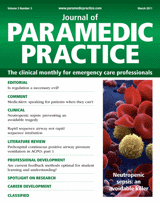References
Essex and Herts Air Ambulance: a focused case series for pre-hospital practice Case 2: tension pneumothorax
Abstract
A tension pneumothorax is an important reversible cause of deterioration in the multiply-injured patient, but it is not always easy to make the diagnosis. Features that indicate the development of a tension pneumothorax can be subtle in the spontaneously breathing patient. The ‘classical’ features may not all be present and in addition, the clinical signs of tension may develop over time with increasing patient compromise. This is a life-threatening situation, which requires relief in order to save the patient's life. A tension pneumothorax can be managed in one of three ways: needle decompression, insertion of an intercostal chest drain or by open thoracostomy. Needle decompression can be performed quickly and safely by paramedic crews using well-established techniques in both the conscious and unconscious patient.
We describe a case of a 55-year-old male who was ejected from his motorcycle at high speed. He was conscious with a Glasgow Coma Score (GCS) of 15 and complaining of difficulty breathing. In contrast to the often quoted classical features of a tension pneumothorax, we review the more common clinical findings in tension pneumothoraces as illustrated in this case study. We aim to show that the diagnosis can be reached by careful history taking, examination, and attention to patient physiology. The case study also shows that a tension pneumothorax can be a dynamic developing situation in which patient compromise develops over time. We highlight that much can be done in the pre-hospital phase to treat such a patient while expediting transfer to hospital. We review the pre-hospital management of a tension pneumothorax and also describe our procedure for pre-hospital chest drain insertion in the context of effective teamwork between a paramedic road crew and an attending helicopter emergency medical service (HEMS).
Essex and Herts Air Ambulance Trust (EHAAT) operate two doctor-paramedic, pre-hospital HEMS teams to provide support to local ambulance crews. The service is predominantly helicopter-based but operates a rapid response car outside daylight hours or in poor weather. The total population covered numbers approximately 3 million people. The team responds to major trauma and medical emergencies, with the latter accounting for approximately 20% of all missions. The paramedics who work for the service are employed by the East of England Ambulance Service NHS Trust, and are seconded to EHAAT for a fixed period. A comprehensive selection process is undertaken and an extensive training programme covering aviation practice and extended clinical management is in place for successful candidates. In addition, EHAAT paramedics have been among the first to enrol and undergo enhanced skill training in anaesthetics and intensive care medicine as part of a formal education programme. We believe that one of the strengths of the service provided by EHAAT lies in our paramedics acting as role models and ambassadors for both our service and the ambulance service in general.
Subscribe to get full access to the Journal of Paramedic Practice
Thank you for visiting the Journal of Paramedic Practice and reading our archive of expert clinical content. If you would like to read more from the only journal dedicated to those working in emergency care, you can start your subscription today for just £48.
What's included
-
CPD Focus
-
Develop your career
-
Stay informed

